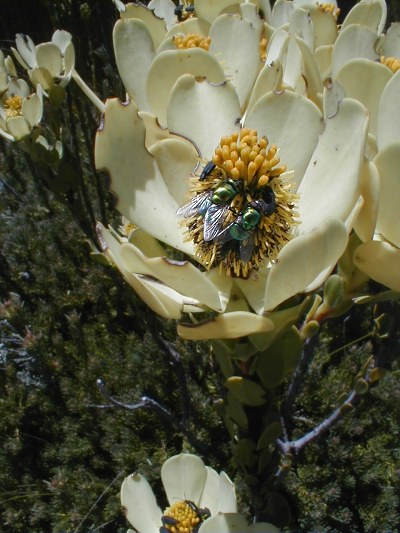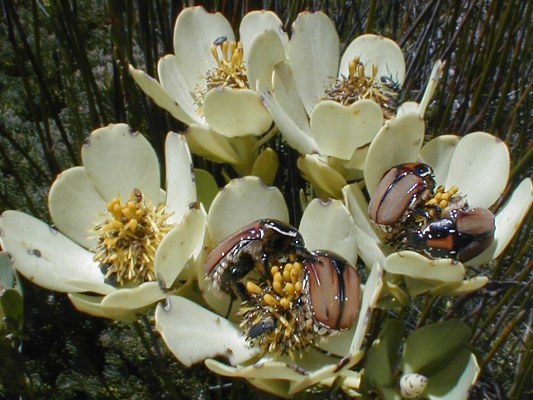
Home
Mission
Overview of Project
Project Staff
Sponsors
Achievements
Checking, Illustrations
Upcoming Activities
Id and Species Lists
Protea Information
Protea Gallery
Growing Proteas
Interim Dist. Maps
Publications
Afrikaanse Inligting
![]()
Pollinators verus Visitors
 In the Protea Atlas Web Site
we noted that the pollinator of Climax Conebush - Leucadendron
climacticum is "Probably small beetles". Can I change this to
"Beetles, Flies and Butterflies". At our visit we saw hundreds of small beetles
on both female and male plants; Protea Scarab Beetles were on males only; flies in lower
numbers on both sexes, and occasional visits by butterflies? Can I assume that flies,
beetles and butterflies pollinate Ld clim or is this a bad assumption? Is a proper study
required to see what is the pollinator?
In the Protea Atlas Web Site
we noted that the pollinator of Climax Conebush - Leucadendron
climacticum is "Probably small beetles". Can I change this to
"Beetles, Flies and Butterflies". At our visit we saw hundreds of small beetles
on both female and male plants; Protea Scarab Beetles were on males only; flies in lower
numbers on both sexes, and occasional visits by butterflies? Can I assume that flies,
beetles and butterflies pollinate Ld clim or is this a bad assumption? Is a proper study
required to see what is the pollinator?
Nigel Forshaw, Oakridge
Flies and a small beetle on Ld climacticum

Scarab Beetles and small beetles on Ld climacticum

Technically, yes, a detailed study is required to ascertain what the pollinators for any species are. In reality, we can take a variety of short cuts.
The symbiosis of pollination is a fascinating field. Simply, the plant provides a reward (usually nectar, pollen or oil) to attract visitors to the flowers. These visitors are dusted, painted, smeared or glued with pollen. When they move to the next flower or flowerhead they take the pollen with them and the stigma captures this pollen, effecting pollination. Thus, as a general rule visitors are pollinators.
The only regular exception to the visitor equals pollinator rule is ants. Ants don’t fly between plants, visit only a few flowers, and tend to stay on one bush before returning to the nest. They also secrete powerful anti-fungicides (to protect the ant colony from fungal parasites) that rapidly kill pollen. There are plants that do use ants as pollinators, but these are low intertwining plants, with lots of near-microscopic flowers offering ants only a sip or two of reward per flower.
The problem is simply that the plants provide a reward, but cannot easily select who comes to the feast. Some plants have narrow flowers restricting access to long-tongued insects and birds, or strong insects such as bees and bumble and carpenter bees (the Pea is a classic bee flower, with a hidden reward requiring force for access). Oil flowers specialize by providing an unusual reward, requiring insects with specialized mops to soak up the oil.
Not all visitors are equally efficient. Some species sit and after eating the pollen, eat the other floral parts. Others rapidly collect their reward and move to the next blossom. Even within a pollinator group, there may be complex patterns of pollen movement. Thus territorial Sugarbirds defend a territory and only move a few tens of metres between flowerheads. However, non-territorial birds that sneak into territories to feed, may be chased hundreds of metres, even kilometres between flowerheads. These distances of pollen transfer determine outcrossing distances and (together with seed movements) gene flow within populations.
And then some pollinators can take large amounts of pollen and resemble powderpuffs and others groom themselves or transport very little pollen. Plants can play with stickiness, electrostatics or glues to get pollen to attach to visitors and to remove it onto the style. Selection will ensure that the plants are moderately efficient given their spectrum of visitors. If cheats exist (visitors who groom or eat pollen) then their abundance will determine if the plants notice them. In reality though, few plant species are highly specialized on a single pollinator. Even classical wind-pollinated species hedge their bets by attracting some flies and bees. And bees and beetles regularly visit even classical bird-pollinated species. Sugarbushes (and Blacktips – Bruniaceae) are probably among the most generalist category of pollination – a mix of birds, rats, beetles, bees and flies visit many of the species. Some of these are important for pollination, and many are inconsequential. But all are potential pollinators and may act as a backup should the more regular species be absent (this may happen when an alternative nectar source becomes available somewhere else – say after a fire).
The most fascinating relationships involve those that cheat. Some plants (e.g. Milkweed Family) attract flies with the promise of carrion and then incarcerate them without any reward for pollination. Some orchids trick newly emerged male wasps into thinking that they are females, or prey items. Here there is no reward (although some men might argue otherwise, given that male wasps emerge well before the females). And the famous Disa uniflora offers no reward, at all luring the Pride of Table Mountain Butterfly with an irresistible red colour. Some visitors peck through the sides of flowers and steal the nectar without intercepting the pollen. The Flowerpeckers of South America are classical avian nectar robbers, thieving from Hummingbird flowers. Some plants have elaborate mechanisms to defeat nectar thieves (sticky traps, robust sepals, deep tubes, etc.)
However, in proteas we can make some simple extrapolations. Sugarbushes tend to be bird-pollinated if aerial and rodent pollinated if on the ground. However, most are visited by a large array of beetles, most especially the Bearded Sugarbushes. Rodent Sugarbushes tend not to attract beetles. The Shale Sugarbushes are pollinated by wasps. We still do not know what pollinates the Rose Sugarbushes. Pincushions are primarily pollinated by birds (all the bigger ones) or bees (the smaller ones). The Sandveld Pincushions with their sweet smells are probably wasp pollinated. Probably all species of Pagodas are bird pollinated,. However, we have little idea what pollinates the Marsh Rose – some bees have been observed feeding on them, but the flowerheads are too elaborate to suggest bee pollination. Apart from 10 species of Conebushes that are predominantly pollinated by wind, the remaining genera and species are insect pollinated. Small beetles (Pria spp) are the major visitors to Conebushes, but only at low numbers. It is thought that females are pollinated as beetles cannot tell the sexes apart and mistakenly visit the females (but see PAN 52.9). Carpenter Bees regularly visit some Scepters, as might moths. Spiderheads are visited by beetles, bees, flies and butterflies - again a generalist strategy. But whereas some Spiderhead species attract large numbers of visitors, other species seem never to be visited. We have very little information on visitors to Powderpuffs and Spoons, but these are likely to be bees and flies.
Amateurs can still make a major contribution to science by observing and recording visitors to our proteas!
What is strange about our new Conebush is the very large numbers of pollinators that hum around the flowerheads. Most other Conebushes require careful searching to find a few small beetles. Ld comosum at Kirstenbosch can also attract many flies and beetles, but we have little data on pollination from the field. Clearly Ld climacticum is not limited by pollination. Why then is it so rare? Might it be spending too many resources on pollination and not enough on seed production?
Tony Rebelo
Back PAN 53